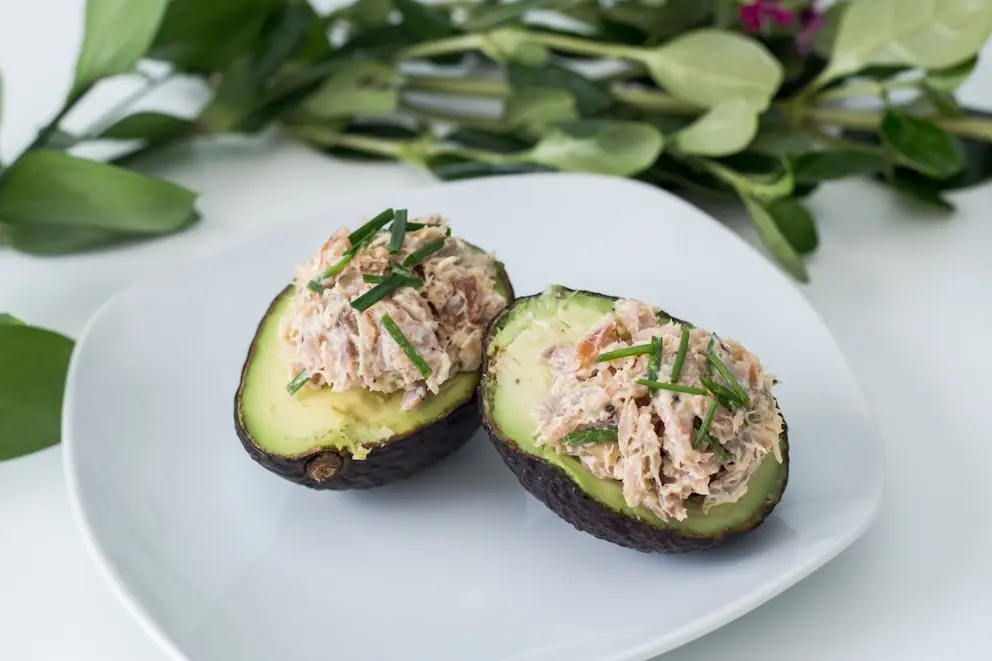Tuna is an excellent source of protein and heart-health-promoting fatty acids that can be used to make a variety of nutritious and satiating meals.
Here are six delicious keto tuna recipes for you to try at home.
6 delicious keto tuna recipes
From savory tuna melts to zesty tuna salads, there are countless ways to enjoy this versatile fish while staying true to your keto lifestyle.
Here are six must-try low-carb tuna recipes that will keep you satisfied and in ketosis.
1. Keto Tuna Salad
This Keto Tuna Salad recipe gets bonus points for freshness by incorporating homemade keto mayonnaise in addition to crunchy celery, a little Dijon mustard, and a sprinkle of fresh dill.
Served in a crisp lettuce wrap, this dish may quickly become your favorite keto tuna salad recipe.
Keto Tuna Salad is also an excellent meal prep recipe, as it can be safely stored in the refrigerator for up to four days. It’s perfect for making tuna melts, patties, or tuna-stuffed avocados.
2. Keto Tuna Avocado Burgers
Elevate your burger game with these juicy tuna patties, creamy avocado, and aromatic herbs and spices.
Nestled between fresh, crispy lettuce buns, these Keto Tuna Avocado Burgers are a savory treat and a highly nutritious keto option.
3. Keto Tuna Stuffed Avocado
Transform your tuna salad into a quick and healthy fat-filled meal with these Keto Stuffed Avocados.
Alternatively, stuff a red or green bell pepper with the tuna mixture, top it with cheddar cheese, and bake it in the oven at 350 degrees F / 176.67 degrees C for about 30 minutes. Garnish with avocado, fresh cilantro, and a drizzle of sriracha for a flavorful dish.

4. Keto Tuna Patties
Keto Tuna Patties are a great appetizer or can be served as a main course.
They pair well with tasty aioli sauce made by mixing a dollop of Greek yogurt, sour cream, or mayonnaise with garlic powder, lemon juice, sriracha sauce, a pinch of sea salt, and black pepper.
5. Tuna Cabbage Casserole
With minimal prep time and a low carb count, this Tuna Cabbage Casserole is a perfect recipe for a quick weeknight dinner that’s keto-friendly and easy to make.
This keto tuna casserole features just a few simple ingredients, including drained canned tuna, tender shredded cabbage, and melty mozzarella cheese.
For added flavor, add finely chopped red onion and garlic powder.
6. Tuna Salad Sandwich
Enjoy a classic Tuna Salad Sandwich without the added carbs by using low-carb keto bread or lettuce wraps.
For a tasty twist, mix in finely chopped red onion, celery, and tangy sugar-free dill relish to your tuna salad. Pile the mixture on your favorite keto bread, top with cheddar cheese, and then broil it in the oven open-face until the cheese is melted to create a keto-friendly tuna melt.

Is tuna high in mercury?
While mercury is naturally present in the environment and can accumulate in fish, certain types of tuna contain higher levels of this toxic metal than others.
Excessive intake of mercury can lead to mercury toxicity, associated with various neurological issues:
Here are common signs and symptoms of mercury toxicity:
- Tremors
- Headaches
- Poor concentration
- Reduced coordination
- Nausea
- Insomnia
- Anxiety
- Muscle weakness
- Twitches
- Poor memory
- Mood swings
However, research published in Science of the Total Environment suggests that mercury’s effects on humans may be mitigated if the fish also contains high concentrations of selenium.1
Selenium can bind with mercury to form a less toxic compound that’s easier to eliminate. However, excessive mercury exposure can overwhelm the body’s ability to process mercury, increasing the risk of toxicity.
Generally, the bigger the fish, the more likely it will have a higher mercury content due to its place in the food chain.
It’s recommended to choose tuna varieties such as skipjack or canned light tuna to minimize mercury exposure.
Avoid albacore, canned white tuna, ahi tuna, yellowfin tuna, and bigeye tuna, as they typically contain more mercury, or opt for tuna products tested for mercury content.
In addition, you can replace tuna with oily fish alternatives, including canned salmon or wild-caught sardines, that have a significantly lower risk of mercury contamination.
Watch this video to learn more about the mercury content in tuna.
Health benefits of tuna
Tuna is a versatile protein and an excellent choice for keto meal prep. When acquired from the right sources, tuna provides several health benefits.
Here are three reasons why you should regularly include tuna in your diet.
1. Promotes healthy weight
Tuna contains plenty of healthy fats and provides a significant amount of low-carb protein, offering around 19 grams per three-ounce (85-gram) serving.
This makes tuna an excellent ingredient for keto-friendly meals that will help you feel full for longer, reducing food cravings and unnecessary snacking linked to weight gain.
2. Supports cognitive function
Tuna is a great source of omega-3 fatty acids, including eicosapentaenoic acid (EPA) and docosahexaenoic acid (DHA). These health-promoting fats are crucial for supporting cognitive functions and regulating inflammatory pathways.
Research published in The Journals of Gerontology: Series A explored the relationship between fish consumption, particularly fatty fish, including tuna, and cognitive function in older adults.2
The researchers found that “Consumption of tuna and dark-meat fish once weekly or higher was associated with a lower decline in verbal memory for a period of four years.”

3. Promotes healthy nutrient stores
Tuna is an excellent source of selenium. This mineral is a powerful antioxidant essential for various critical functions, including DNA repair, immune function, and thyroid health.
A serving of tuna contains between 30 to 92 micrograms (mcg) of selenium. This significantly contributes towards the recommended daily selenium intake of 55 mcg, as suggested by the National Institute of Health (NIH).3
In addition to selenium, tuna also provides a significant amount of the daily recommended intake value of vitamin B12.
According to research published in Nutrients, vitamin B12 is crucial for red blood cell production and neuronal health while offering potent antioxidant properties.4
Collectively, the nutrients in tuna can help protect cells and tissues from oxidative stress linked to the development of cancer, neurodegenerative diseases, and cardiovascular issues.

Wild-caught vs. farm-raised tuna
To benefit from the best quality tuna, choosing wild-caught over farm-raised options is crucial.
“Farm-raised fish are fed an inflammatory diet of genetically modified ingredients such as cornmeal, soybean meal, wheat, and canola. This means it also may contain residues of glyphosate, a toxic herbicide, and sometimes antibiotics, which can damage your gut microbiome,” says Dr. Berg.
In addition, farm-raised tuna tend to have a less favorable omega-6 to omega-3 fatty acid ratio compared to their wild-caught counterparts.
A healthy omega-6 to omega-3 ratio should be about 1 to 1, meaning that for every gram of omega-6 fatty acids consumed, you should ideally consume approximately one gram of omega-3 fatty acids.
Farm-raised fish contain three times the amount of inflammatory omega-6 fatty acids and only half the amount of beneficial omega-3 fats. This imbalance can contribute to chronic inflammation and associated health issues.

Key takeaways
There are endless delicious and nutritious keto tuna recipes offering protein, essential fatty acids, and selenium while keeping you in ketosis.
When possible, opt for wild pole-caught tuna, as it’s a much more nutritious option compared to farm-raised tuna.
Some large tuna species, such as ahi and yellowfin tuna, can be prone to high mercury levels. It’s recommended to opt for smaller varieties, such as skipjack and canned light tuna, to minimize mercury exposure.
FAQ
1. Is canned tuna keto-friendly?
Yes, canned tuna can be keto-friendly. It’s high in protein and healthy fats while being low in carbohydrates.
Choose tuna varieties lower in mercury, such as skipjack or light tuna. Aim for options packed in water or extra virgin olive oil, and avoid any products that include seed oil, vegetable oil, or added carbohydrates or sugar.
2. What is the healthiest type of tuna?
The healthiest type of tuna is wild-caught, skipjack, or canned light tuna. These options have a better omega-3 to omega-6 fatty acid ratio than farmed fish and are at lower risk of mercury contamination.
3. What type of tuna contains the lowest amount of mercury?
Skipjack and canned light tuna typically contain the lowest amounts of mercury, making them safer choices for frequent consumption.
Sources
- https://www.sciencedirect.com/science/article/abs/pii/S004896971933654X ?
- https://www.ncbi.nlm.nih.gov/pmc/articles/PMC3779629/ ?
- https://ods.od.nih.gov/factsheets/Selenium-HealthProfessional/#h5 ?
- https://pubmed.ncbi.nlm.nih.gov/30823595/ ?







